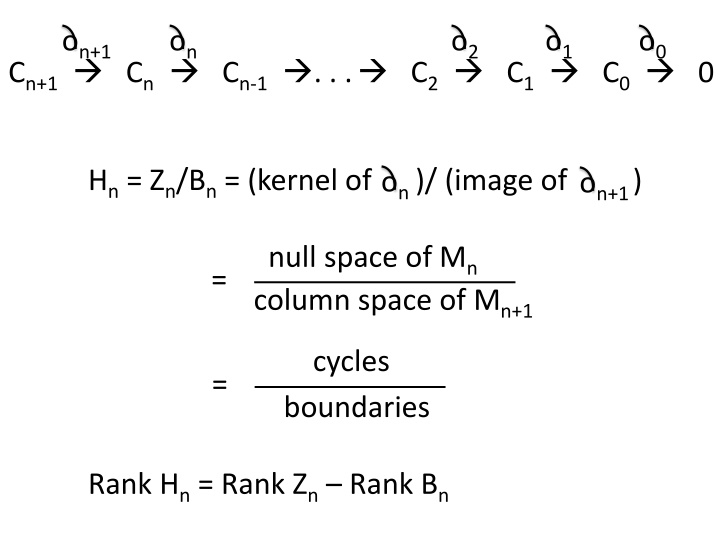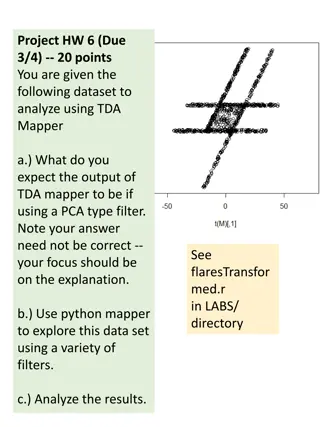
Homology in Mathematics
Explore the concept of homology through mathematical structures such as cycles, boundaries, and kernel/image spaces. Learn how to count connected components and analyze 1-dimensional cycles using linear extensions. Visual aids and examples help in grasping the intricate relationships in this mathematical field.
Download Presentation

Please find below an Image/Link to download the presentation.
The content on the website is provided AS IS for your information and personal use only. It may not be sold, licensed, or shared on other websites without obtaining consent from the author. If you encounter any issues during the download, it is possible that the publisher has removed the file from their server.
You are allowed to download the files provided on this website for personal or commercial use, subject to the condition that they are used lawfully. All files are the property of their respective owners.
The content on the website is provided AS IS for your information and personal use only. It may not be sold, licensed, or shared on other websites without obtaining consent from the author.
E N D
Presentation Transcript
on+1 on o2 o1 o0 Cn+1 Cn Cn-1 . . . C2 C1 C0 0 Hn = Zn/Bn = (kernel of )/ (image of ) on on+1 null space of Mn column space of Mn+1 boundaries = cycles = Rank Hn = Rank Zn Rank Bn
Counting number of connected components using homology v2 v5 o0 o1 C1 C0 0 e1 e2 e3 e4 v1 v3 v4 v6 e5 Z0/B0 = <v1, v2, v3, v4, v5, v6 : v1 + v2 = 0, v2 + v3 = 0, v4 + v5 = 0, v5 + v6 = 0, v4 + v6 = 0> Z0/B0 = <[v1], [v4]> where [v1] = {v1, v2, v3} and [v4] = {v4, v5, v6}
v2 v5 Counting 1-dimensional cycles: e1 e2 e3 e4 v1 v3 v4 v6 e5 o2 o1 C2 C1 C0 H1 = Z1/B1 = (kernel of )/ (image of ) o1 o2 null space of M1 column space of M2 = Rank H1 = Rank Z1 Rank B1
v2 v5 o1 e1 e2 e3 e4 C1 C0 v1 v3 v4 v6 e5 Z1 = kernel of = null space of M1 o1
Let e1 = {v1, v2} = Let e2 = {v2, v3} = Let e3 = {v4, v5} = Let e4 = {v5, v6} = Let e5 = {v4, v6} =
v1 = , v2 = , v3 = , v4 = , v5 = v6 =
v2 v5 o(e1) = v1 + v2 e1 e2 e3 e4 v1 v3 v4 v6 e5
v2 v5 o(e2) = v2 + v3 e1 e2 e3 e4 v1 v3 v4 v6 e5
v2 v5 o(e3) = v4 + v5 e1 e2 e3 e4 v1 v3 v4 v6 e5
v2 v5 o(e4) = v5 + v6 e1 e2 e3 e4 v1 v3 v4 v6 e5
v2 v5 o(e5) = v4 + v6 e1 e2 e3 e4 v1 v3 v4 v6 e5
Counting number of connected components using homology v2 v5 e1 e2 e3 e4 v1 v3 v4 v6 e5 : C1 C0 o o(e1) = v1 + v2 o(e2) = v2 + v3 Extend linearly: ( niei) = ni (ei) o o o(e3) = v4 + v5 o(e4) = v5 + v6 o(e5) = v4 + v6
o2 o1 C2 C1 C0 Z1 = kernel of = null space of M1 o1
o2 o1 C2 C1 C0 Z1 = kernel of = null space of M1 o1
New basis Let e1 = {v1, v2} = Let e2 = {v2, v3} = Let e3 = {v4, v5} = Let e4 = {v5, v6} = Let b5 = e3 + e4 + e5
o2 o1 C2 C1 C0 Z1 = kernel of = null space of M1 = <e3 + e4 + e5> o1
o2 o1 v2 C2 C1 C0 e1 e2 v1 v3 v5 e3 e4 v4 v6 e5 B1 = image of = column space of M2 o2
v2 o2 o1 C2 C1 C0 e1 e2 v1 v3 v5 e3 e4 v4 v6 e5 B1 = image of = column space of M2 o2 = <{v4, v5} + {v5, v6} + {v4, v6}> = <e3 + e4 + e5>
v2 v5 o2 o1 e1 e2 e3 e4 C2 C1 C0 v1 v3 v4 v6 e5 H1 = Z1/B1 = (kernel of )/ (image of ) o1 o2 null space of M1 column space of M2 = <e3 + e4 + e5> <e3 + e4 + e5> = Rank H1 = Rank Z1 Rank B1 = 1 1 = 0
v2 o2 o1 C2 C1 C0 e1 e2 v1 v3 v5 e3 e4 v4 v6 e5 B1 = image of = column space of M2 o2 = <{v4, v5} + {v5, v6} + {v4, v6}> = <e3 + e4 + e5>
v2 o2 o1 C2 C1 C0 e1 e2 v1 v3 v5 e3 e4 v4 v6 e5 B1 = image of = column space of M2 o2 = <{v4, v5} + {v5, v6} + {v4, v6}> = <e3 + e4 + e5>
v2 v5 o2 o1 e1 e2 e3 e4 C2 C1 C0 v1 v3 v4 v6 e5 H1 = Z1/B1 = (kernel of )/ (image of ) o1 o2 null space of M1 column space of M2 = <e3 + e4 + e5> <e3 + e4 + e5> = Rank H1 = Rank Z1 Rank B1 = 1 1 = 0










